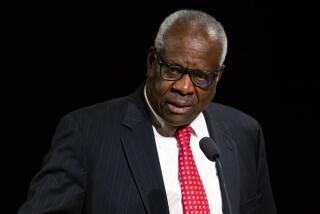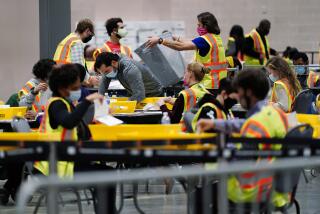Justices are asked to dismiss officials from detainees’ suit
WASHINGTON — Since 9/11, the Bush administration has successfully fended off suits by many victims of its war-on-terrorism policies not by showing their charges are false, but by relying on legal barriers that prevent the suits from being heard.
Lawyers for the administration were able to kill a lawsuit against its wiretapping policy by saying those who sued could not prove they had been wiretapped. Therefore, they had no standing to sue.
They blocked lawsuits from several people who say they were wrongly captured and tortured by the CIA on the grounds that they could expose state secrets.
The latest example of this approach came Wednesday, when a top Bush administration lawyer urged the Supreme Court to throw out a lawsuit against former Atty. Gen. John Ashcroft and FBI Director Robert S. Mueller III on allegations that they ordered the arrest and jailing of Muslim men in the New York area after the attacks of Sept. 11, 2001.
More than 700 Muslim or Arab men were taken into federal custody that fall, and many were held in solitary confinement for months. None were charged with terrorism crimes, although many were found guilty of immigration offenses.
Their suits allege that they were arrested and held because of their race and religion, and that they were subjected to strip searches and other abuses in jail.
But U.S. Solicitor General Gregory G. Garre said the suit against Ashcroft and Mueller should be thrown out because the Muslim men could not show the “personal involvement of those high-ranking officials in the alleged discriminatory acts.” Because they lacked this proof in their original complaint, the suit should be dismissed at the pleading stage, Garre said.
Lawyers for the Muslim men called this a classic Catch-22.
“Plaintiffs will never be able to provide the level of detail Ashcroft and Mueller would demand at the beginning of a lawsuit, because that information is in the exclusive control of the government,” said Rachel Meeropol, a lawyer at the Center for Constitutional Rights. “It’s a Catch-22 that would always let high-level officials off the hook,” she said.
But Garre’s argument won a sympathetic hearing from the high court. He called the FBI’s decision to arrest and question Muslim men “a perfectly lawful law enforcement response” to the attacks. Ashcroft and Mueller “are entitled to a dismissal” of the suit, he said, so they are not forced to respond to questions.
Chief Justice John G. Roberts Jr. and Justices Antonin Scalia, Samuel A. Alito Jr. and even the normally more liberal Stephen G. Breyer appeared to agree with the argument.
“I don’t know on what basis any of these allegations against the high-level officials are made,” Scalia said.
A lawyer for one of the men said there was evidence that the attorney general played a key role in the mass arrests. “We know that [Ashcroft and Mueller] ordered to have certain groups targeted for question and detention,” Alexander Reinert, a lawyer from Yonkers, N.Y., told the justices. The top officials also ordered the Muslims to be subjected to “conditions of confinement as harsh as possible,” he added.
Reinert, a professor at the Benjamin N. Cardozo School of Law in New York, was representing Javaid Iqbal, a Pakistani native who had worked as a television cable installer on Long Island before 9/11. Iqbal was arrested and kept in solitary confinement for 150 days before being released. He was not charged with any crime related to terrorism. He pleaded guilty to working with a false Social Security number and was deported to Pakistan. He then sued dozens of officials for his arrest and imprisonment, including the former attorney general and the FBI director.
A federal judge in Brooklyn as well as the U.S. Court of Appeals in Manhattan allowed his suit to proceed. Those judges said Iqbal had alleged an unconstitutional policy of singling out men for arrest because of their race and religion. However, the trial judge shielded Ashcroft and Mueller from answering questions until the plaintiffs had learned more from lower-level officials.
Reinert called this a balanced approach that should be affirmed.
But most of the justices who spoke during Wednesday’s argument said Ashcroft and Mueller should be dismissed from the suits. In the wake of the 9/11 attacks, they said, it was expected that top officials at the Justice Department would seek to arrest and question those who might know something about the hijackers or other terrorist plots.
“If they are looking for suspects from 9/11 . . . it’s not surprising that they might look for people who looked like Arabs,” Breyer said. “That isn’t surprising to me, because that’s what the suspects looked like. . . . It was for every good reason. We didn’t want more bombs to go off.”
Reinert warned the justices against setting a special rule for 9/11 cases that shields high-level officials from answering for unconstitutional policies they set.
Only Justices Ruth Bader Ginsburg and David H. Souter spoke up for allowing the lawsuit to proceed. They said the federal rules for civil lawsuits allow claims from plaintiffs who say their rights were violated.
The court in the past has rejected “any heightened pleading rules,” Ginsburg said.
If Ashcroft and Mueller are dismissed from the suit, the plaintiffs could proceed with their claims against lower-level officials.
In addition to Iqbal’s suit, the Center for Constitutional Rights brought a separate class-action suit on behalf of several hundred Muslim men who were held in solitary confinement. It too is pending in a federal court in New York.
Later this week, the court will meet to decide whether to hear an appeal from four former prisoners who say they were abused and tortured at the U.S. military prison at Guantanamo Bay, Cuba. Their suit against top Defense officials was thrown out by an appeals court, which said the prisoners did not have constitutional rights.--
More to Read
Get the L.A. Times Politics newsletter
Deeply reported insights into legislation, politics and policy from Sacramento, Washington and beyond. In your inbox three times per week.
You may occasionally receive promotional content from the Los Angeles Times.











